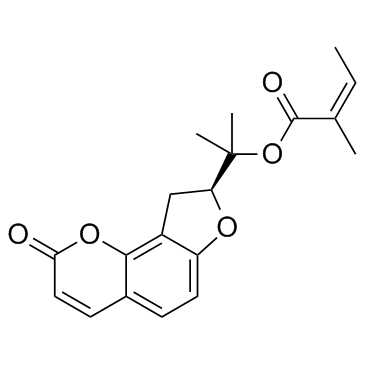| Description |
Columbianadin, a natural coumarin from, is known to have various biological activities including anti-inflammatory and anti-cancer effects.
|
| Related Catalog |
|
| Target |
Apoptosis[1]
|
| In Vitro |
Columbianadin (CBN) effectively suppresses the growth of colon cancer cells. Low concentration (up to 25 μM) of Columbianadin induces apoptosis, and high concentration (50 μM) of Columbianadin induces necroptosis. The induction of apoptosis by Columbianadin is correlated with the modulation of caspase-9, caspase-3, Bax, Bcl-2, Bim and Bid, and the induction of necroptosis is related with RIP-3, and caspase-8. In addition, Columbianadin induces the accumulation of ROS and imbalance in the intracellular antioxidant enzymes such as SOD-1, SOD-2, catalase and GPx-1. Columbianadin shows the most effective growth inhibitory activity against human colorectal cancer cells. Accordingly, further study is performed using HCT116 cells to give the detailed growth-inhibitory mechanism of action mediated by Columbianadin. The cells treated with various concentrations of Columbianadin (0-100 μM) exhibit a dose- and time-dependent growth inhibition with an IC50 value of 47.2 and 32.4 μM after 48 and 72 h incubation, respectively. Treatment of various concentrations (12.5, 25, and 50 μM) of Columbianadin for 48 h in HCT116 cells decreases the number of cells and increases the floating cells. Apparent morphological changes with round-shape and dying cells are also observed at 25 and 50 μM Columbianadin -treated cells[1].
|
| In Vivo |
The analysis method is successfully applied to a tissue distribution study of Columbianadin (CBN) and Columbianetin (CBT) after intravenous administration of Columbianadin to rats. The results of this study indicated that Columbianadin can be detected in all of the selected tissues after i.v. administration. Columbianadin is distributed to rat tissues rapidly and can be metabolized to CBT in most detected tissues. Of the detected tissues, heart had the highest uptake of Columbianadin, which suggests that heart might be one of the main target tissues of Columbianadin [2].
|
| Cell Assay |
The effect of Columbianadin on the cell proliferation is evaluated by SRB cellular protein-staining method. The cells are seeded in 96-well plates with various concentrations of Columbianadin and incubated at 37°C in a humidified incubator with 5% CO2 for 48 and 72 h. The cells are fixed with 10% trichloroacetic acid (TCA) solution for 30 min at 4°C, washed 5 times with tap water, and dried in the air. The cells are stained with 0.4% SRB in 1% acetic acid solution for 1 h at room temperature. After washing out the unbound dye and drying, the stained cells are dissolved in 10 mM Tris buffer (pH 10.0), and the absorbance is measured at 515 nm. Cell viability is calculated by comparing to the absorbance of the vehicle-treated control group. The IC50 values are calculated by non-linear regression analysis using the Table Curve 2D v5.01 software[1].
|
| Animal Admin |
Rats[2] For tissue distribution study, 20 male Sprague-Dawley rats (200±10 g) are divided into four groups (n=5 per group), and Columbianadin is i.v. administered to overnight fasted rats at a single dose of 20 mg/kg. The rats in the four groups are sacrificed by decapitation at 10, 30, 60 and 120 min. Then the tissues of liver, lung, kidney, spleen, heart, stomach, intestine, brain, testis and muscle are removed and washed. Each tissue sample is weighted and stored at -20 °C until analysis.
|
| References |
[1]. Kang JI, et al. Columbianadin Inhibits Cell Proliferation by Inducing Apoptosis and Necroptosis in HCT116 Colon Cancer Cells. Biomol Ther (Seoul). 2016 May 1;24(3):320-7. [2]. Zhang YB, et al. Tissue distribution study of columbianadin and its active metabolite columbianetin in rats. Biomed Chromatogr. 2016 Feb;30(2):256-62.
|


